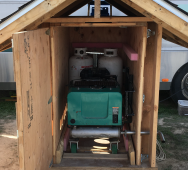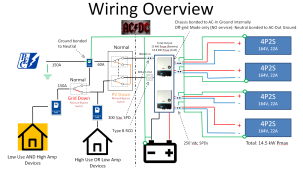@Samsonite801
I am also using the Onan 6.3 kw RV gen set for my backup power plant. These are factory wired for 120 volts 2 seperate circuits to run dual air conditioners on Class A motorhomes. They do not have a neutral ground bond from Onan. Sometimes that is changed by the motorhome builder. They have two seperate windings that can be connected as two separate 30 amp services but can also be wired as 240 volts or 120/240 volts as desired.
I do have the factory service manuals as well and through an acquaintance on another forum do have access to a treasure trove of Onan manuals that can be downloaded for free from an Onan hobbyist group.
I think that my big Onan is a model NH3, but not exactly sure right now if that is exact. I also possess 3 Onan Emerald 4 units 4.0 kw 120 volt units that have a single winding for 120 volts only.
I store all my documents in Adobe in .PDF format and am willing to share all that I have and will point you to that forum user who also has a Onan Parts business, though mostly engine parts, both new and used. He is a very avid off gridder and very willing to share. His prices on parts are hard to beat...
Yeah, the reason I bought this Onan 6.3 on the cart with wheels, is because my motorhome (seen behind in the above picture), also has an Onan 6.3 onboard, and I figured it's better to have 2 gensets with same parts so if one breaks, I can use the other for parts.
I have already had a chance to take advantage of this. I am off-grid like 50 miles from the nearest town, and my Onan in the doghouse shed stopped running. I troubleshot it to a bad coil, so I took the one off the motorhome and had it back up and running in minutes. Then later on at my convenience, I ordered a new coil back in town and brought it back out to fix the one back up in the motorhome, so they both run again.
I also got that second Onan because the one in the motorhome runs on liquid propane feed, and it's not easy to fill the stationary tank in the motorhome (until I come up with a remote fast fill solution)... The Onan in the doghouse runs on vapor propane directly, so no evaporator on the exhaust, it just takes the standard RV 7.5 gal vapor-feed bottles, so is easy to swap out when they run out.
I do have a vapor tee-kit plumbed in to the motorhome so I can run the motorhome furnace, fridge and stuff off the 7.5 bottles, but not for liquid yet, so I use the motorhome Onan sparingly for now. I did buy a large mobile truck propane tank, I want to see if I can put a pump on it and make it a filling station for my motorhome main tank at some point.
I would like to have access to your manuals if you don't mind. I have a couple PDFs I found on my Safari manuals disk and it was how I was able to study the ignition circuit and figure out how to troubleshoot my coil problem a little easier, but I would like to see your manuals and compare.
I had been wondering if these Onans could be wired for 240v... The Onan in the doghouse on the cart, was prewired for 2x 120v, it has one 30a RV plug, and a 20a dual 120v traditional receptacle mounted on it.
BTW, thanks a lot for taking the time to respond with helpful info







